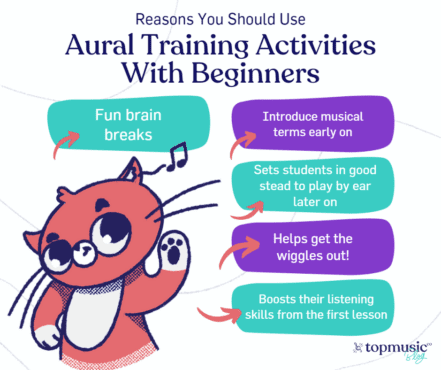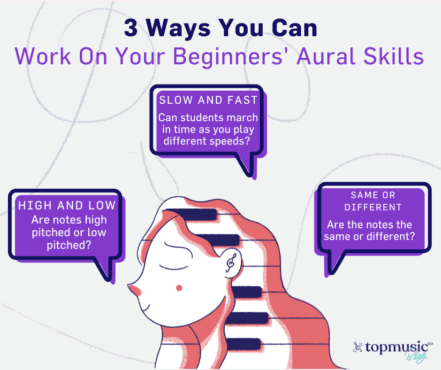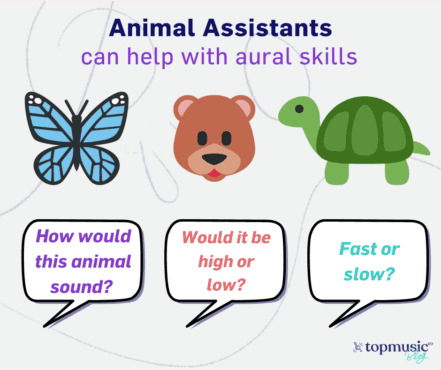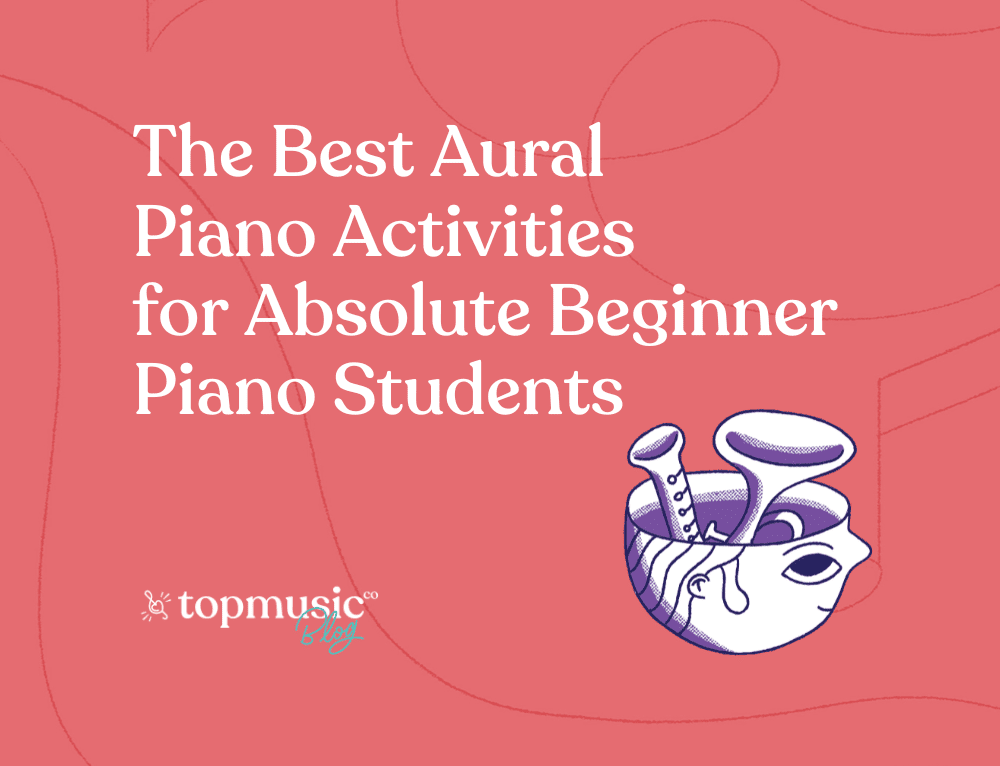Try these 6 aural piano activities and your beginner piano students will be begging for more ear training time as they listen, jump and march.
Forget about cadences, inversions and singing “here comes the bride” to remind about intervals. Today we’re talking about aural piano activities you can do right from the word go.
These aural piano activities are not only great for your new students’ ears. They also serve as wonderful brain breaks or off-the-bench time.
These ideas all work great for private lessons, but I especially love to use them during overlapping and partner lessons – they’re even more fun with more kiddos!
Table Of Contents:
These first three aural activities can take as little as two minutes (no excuses!) out of your lesson time and will definitely get the wiggles out. Use them as a warm-up or as a transition between different parts of the lesson.
Adapt any of these ideas to your student’s age and abilities by letting them look at the piano (to make it easier) or turning them to face the other way (to make it more challenging).

The rules are simple:
Play lots of different styles of high and low notes such as staccato, long notes, loud, and soft. This will help students to really hone in on the concept of high and low specifically.
To add an extra level add a chair/bench into the mix and start including middle notes. You could also try playing different instrument samples (recordings or using digital piano sounds) so your student gets used to the different timbres.
Another great one for wriggly students!
Once this becomes easy for your student, teach them the Italian tempo terms to use. Just a few will do in the beginning such as: Largo, Andante and Allegro. Now you get the extra bonus of being ahead of the game on those music terms.
Yes, really. If you haven’t taught as many very young beginners as I have you might think this one is unnecessary – but it isn’t.
If your student can’t identify if pitches are the same or different, they’re going to have a very hard time playing anything by ear and noticing patterns. So make it fun with this interactive aural practice.
Done in this way, it doesn’t need to look like a “test” and it will give you valuable insight into your student’s musical ear.
For another fun way to practice these basic listening concepts (especially with preschoolers) try these free listening paddles.

Now we come to my favourite aural activities for beginners – using my little animal assistants.
Many children won’t have been exposed to much classical music when they get to me. These animal pieces are a great place to start as they’re familiar territory to latch onto, and give the kids vivid imagery to associate with the pieces.
You’re welcome to use this playlist in your own lessons too. It’s roughly in the order I would introduce the animals, although the sequence isn’t really all that important.
The first of these aural activities is just about getting acquainted with the animals. I start with The Bear as this piece is particularly distinctive.
Introduce just 2-3 new animals in this way at the first lesson. Next time, review these animals and only introduce more if she can recognise these first ones without help.
Continue this identification process at each lesson until you have the full set and mix in the aural activities below as you go.
The bonus of this one is that your student will get extra practice feeling the beat by marching around the room.
This is great fun. Students can get really creative with how they act out the butterfly, or bear, or tortoise.

You can also use the animals as a jumping-off point for some improvisation.
Take this a step further and get two of the animals interacting together. What would it sound like if the bear met the kangaroo? Can you create a musical story together using the animal characters?
The next time you want to practice ear training with your students, please don’t bring out some dull and dry exercises.
Use these ideas as a springboard to think about your own ideas for aural activities. How can you make it more active and interactive?
Lessons with beginner students should be fun, interactive, and full of opportunities to be creative. Instead of turning to the method book straight away, encourage them to be creative and fully engaged with music.
The best way to do this? With the No Book Beginners Course.

Carl Tulumello says:
Hi,
I taught my son how to play Alice DJ and it made it easier by finding the same synth as in the original song. By ear only and picked it up within a week. First song he’d ever learnt!
Rebecca Singerman-Knight says:
Some brilliant ideas here. Thank you Tim and Nicola!
Nicola Cantan says:
Thanks for reading Rebecca! Let me know if you try any of the ideas out. 🙂